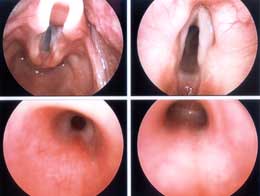What are a Microscopic Laryngoscopy, Bronchoscopy and Esophagoscopy?
Microscopic laryngoscopy and bronchoscopy (Micro L and B) is a procedure that uses a special telescope to look into the upper and lower airway. The telescope allows for a close-up view of the airway.
The telescope is passed through the mouth into the throat. The larynx (voice box), trachea (windpipe) and bronchi (lower branches of the windpipe) can be seen. This procedure is done to look at the parts of the airway and to look for any problems.
Signs and Symptoms of Airway Problems
- Noisy breathing
- Persistent coughing
- Weak cry
- A hoarse voice
- Blockage of the airway
- Repeated breathing problems
- A foreign body in the airway
- Severe neck injury
Esophagoscopy
An esophagoscopy is performed to look at the esophagus (swallowing tube). Problems in this area can sometimes affect the airway or cause difficulty feeding.
A special telescope is placed through the mouth into the esophagus. This is done to check for any problems that may cause or increase breathing problems or cause swallowing difficulty.
| Views of a normal, healthy airway | ||||
 |
||||
|
After the Procedure
Following the procedure, your child may have a dry or sore throat. You may offer your child clear liquid after you return home. This may help soothe the throat.
Acetaminophen (Tylenol, Tempra, Panadol) may be given for a sore throat. Your child may also have a hoarse voice or cough. This should be mild and go away soon. If you would like, you may use a humidifier at home.
Your child may continue with the same symptoms they had before the procedure. However, if your child displays any serious changes, or if the symptoms increase, you should call your otolaryngology (ear, nose and throat, or ENT) doctor immediately.



